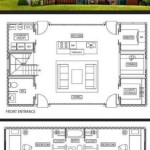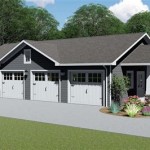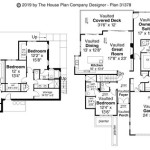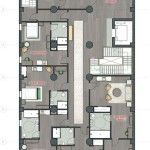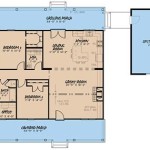4 Bedroom House Plans and Cost to Build
Building a 4-bedroom house represents a significant investment, encompassing both the design phase and the actual construction. Prospective homeowners often seek readily available plans and accurate cost estimates to initiate the project effectively. Understanding the various factors influencing both plan selection and construction pricing is crucial for making informed decisions throughout the building process.
The demand for 4-bedroom houses stems from several factors, including the need for extra space for growing families, dedicated home offices, guest rooms, or hobby areas. These homes offer flexibility and adaptability, accommodating diverse lifestyle needs. As such, the architectural design and the associated building costs are primary considerations for anyone planning to construct such a residence.
This article aims to provide a comprehensive overview of 4-bedroom house plans, exploring different architectural styles, spatial arrangements, and key design considerations. Furthermore, it will delve into the various cost components involved in building a 4-bedroom house, offering insights into material selection, labor expenses, and potential cost-saving strategies. This information is intended to equip readers with the knowledge necessary to navigate the complexities of planning and building their dream home.
Architectural Styles and 4-Bedroom House Plans
The architectural style of a 4-bedroom house significantly impacts its overall aesthetic appeal and functionality. Different styles cater to varying preferences and geographical locations. Several popular architectural styles are frequently adapted for 4-bedroom house plans:
Ranch Style: Ranch-style homes, characterized by their single-story layout and sprawling footprint, often feature an open floor plan and an emphasis on indoor-outdoor living. These plans are particularly well-suited for larger lots and can be easily adapted to accommodate four bedrooms. Ranch-style homes typically have a lower roof pitch and a more horizontal appearance, making them accessible and appealing to a wide range of homeowners.
Two-Story Traditional: Two-story traditional homes frequently incorporate features such as gabled roofs, symmetrical facades, and formal living spaces. These designs often place the bedrooms on the upper level, creating a clear separation between living and sleeping areas. Traditional-style homes are commonly found in suburban neighborhoods and offer a timeless and classic aesthetic.
Modern Farmhouse: The modern farmhouse style blends traditional farmhouse elements with contemporary design features. These homes typically incorporate board-and-batten siding, large windows, and open floor plans. Modern farmhouse plans often feature a large kitchen island, a spacious great room, and a wrap-around porch, creating a comfortable and inviting living space.
Contemporary: Contemporary house plans emphasize clean lines, minimalist design, and a focus on functionality. These homes often feature flat or low-pitched roofs, large windows, and an abundance of natural light. Contemporary designs may incorporate sustainable building materials and energy-efficient technologies. The interior spaces are typically open and flexible, allowing for customization and personalization.
Craftsman: Craftsman-style homes are characterized by their detailed woodwork, exposed rafters, and front porches with tapered columns. These homes often feature built-in cabinets, fireplaces, and other handcrafted details. Craftsman plans typically have a more compact footprint and a focus on quality craftsmanship. The materials used in Craftsman homes are often natural and earthy, such as wood, stone, and brick.
Selecting the appropriate architectural style is a crucial step in the planning process. Factors to consider include personal preferences, budget constraints, lot size, and neighborhood context. Consulting with an architect or designer can help homeowners determine the most suitable style for their needs and preferences.
Within each architectural style, numerous variations exist. 4-bedroom house plans can be customized to include features such as master suites with walk-in closets and ensuite bathrooms, dedicated home offices, media rooms, and outdoor living spaces. The layout of the bedrooms can also be tailored to suit specific family needs, with options for split bedroom plans, clustered bedrooms, or separate guest suites.
Online resources and plan providers offer a wide selection of pre-designed 4-bedroom house plans. These plans can provide a starting point for the design process and can be modified to meet individual requirements. However, it is advisable to consult with a qualified professional to ensure that the chosen plan meets local building codes and zoning regulations.
Key Design Considerations for 4-Bedroom Houses
Beyond the architectural style, several key design considerations play a vital role in creating a functional and comfortable 4-bedroom house. These considerations include spatial arrangements, room sizes, storage solutions, and energy efficiency.
Spatial Arrangement: The arrangement of rooms within a 4-bedroom house should prioritize functionality and flow. An open floor plan, connecting the living room, dining area, and kitchen, can create a spacious and inviting atmosphere. Conversely, a more traditional layout with defined rooms can offer greater privacy and separation. The placement of bedrooms should consider noise levels and privacy needs. Master suites are often situated away from the other bedrooms to provide a more secluded retreat. Consider the traffic flow throughout the house, ensuring easy access to all areas.
Room Sizes: Adequate room sizes are essential for comfortable living. Bedrooms should be large enough to accommodate beds, dressers, and other furniture without feeling cramped. Living rooms and dining areas should be sized appropriately for the anticipated number of occupants. The kitchen should provide ample counter space and storage for cooking and meal preparation. When planning room sizes, consider future needs and potential changes in lifestyle. A flexible design can accommodate evolving family dynamics and changing needs.
Storage Solutions: Sufficient storage is crucial for maintaining an organized and clutter-free home. 4-bedroom houses typically require ample storage space for clothing, linens, household items, and seasonal decorations. Walk-in closets in the master suite, linen closets in the bathrooms, and pantry storage in the kitchen are essential. Additional storage can be incorporated into hallways, garages, and basements. Consider utilizing vertical space with shelving and built-in cabinets. Effective storage solutions can significantly enhance the functionality and livability of a 4-bedroom house.
Energy Efficiency: Incorporating energy-efficient features into the design and construction of a 4-bedroom house can significantly reduce utility costs and environmental impact. Energy-efficient windows and doors, proper insulation, and a high-efficiency HVAC system are essential components. Consider using sustainable building materials and incorporating passive solar design principles. Solar panels can provide renewable energy and reduce reliance on fossil fuels. Energy-efficient appliances and lighting can further reduce energy consumption. Many local and federal incentives are available for homeowners who invest in energy-efficient upgrades.
Accessibility: Universal design principles should be considered to ensure that the house is accessible to people of all ages and abilities. Features such as wider doorways, grab bars in bathrooms, and a no-step entry can improve accessibility for elderly residents or individuals with disabilities. Single-story layouts can eliminate the need for stairs altogether. Even if accessibility is not currently a concern, incorporating these features can increase the long-term value and usability of the house.
Outdoor Living Spaces: Integrating outdoor living spaces into the design of a 4-bedroom house can extend the living area and enhance the enjoyment of the property. Patios, decks, porches, and outdoor kitchens can provide spaces for relaxation, entertaining, and dining. Consider the orientation of the house to maximize sunlight and views. Landscaping can create privacy and enhance the aesthetic appeal of the outdoor spaces. Outdoor living spaces can significantly increase the overall appeal and value of a 4-bedroom house.
Cost Components of Building a 4-Bedroom House
The cost of building a 4-bedroom house can vary significantly depending on several factors, including the location, the architectural style, the quality of materials, and the complexity of the design. Understanding the various cost components involved is essential for creating a realistic budget and managing expenses effectively. The following outlines the major cost factors:
Land Acquisition: The cost of land is a significant component of the overall building cost. Land prices vary widely depending on the location, size, and zoning regulations. Factors such as proximity to schools, amenities, and transportation can also affect land values. Conducting thorough research on land prices in the desired area is crucial for accurate budgeting. Surveys, soil testing, and other pre-construction assessments may add to the initial land costs.
Permits and Fees: Building permits and other regulatory fees are required to ensure that the construction project complies with local codes and regulations. Permit costs can vary depending on the municipality and the scope of the project. It is essential to obtain all necessary permits before commencing construction to avoid delays and penalties. Architectural and engineering fees are also included in this category, covering the cost of design plans and structural engineering services.
Materials: The cost of building materials represents a substantial portion of the overall construction budget. The choice of materials, such as lumber, concrete, roofing, siding, windows, doors, flooring, and fixtures, can significantly impact the final cost. High-quality materials typically cost more but offer greater durability and longevity. Consider balancing cost with quality when selecting materials. Negotiating with suppliers and comparing prices can help reduce material costs.
Labor: Labor costs include the wages paid to contractors, subcontractors, and other construction workers. Labor rates can vary depending on the location, the skill level of the workers, and the demand for construction services. Obtaining multiple bids from qualified contractors is essential for securing competitive pricing. Clear communication and a well-defined contract can help prevent misunderstandings and cost overruns.
Foundation: The foundation is the base of the house and a critical component in the overall structural integrity. Foundation costs can vary depending on the type of foundation (e.g., slab-on-grade, crawl space, or basement) and the soil conditions. Proper preparation and installation of the foundation are essential for preventing future problems. Addressing issues such as poor soil drainage or unstable ground can increase foundation costs.
Framing: The framing provides the structural framework of the house. Framing costs include the cost of lumber and the labor required to erect the walls, roof, and floors. The complexity of the design can impact framing costs. Intricate roof designs or unusual wall configurations can increase labor and material expenses.
Roofing: The roofing system protects the house from the elements. Roofing costs depend on the type of roofing material (e.g., asphalt shingles, tile, metal) and the complexity of the roof design. Durable and long-lasting roofing materials typically cost more but offer better protection and require less maintenance. Proper installation is essential for preventing leaks and extending the lifespan of the roof.
Plumbing and Electrical: Plumbing and electrical systems are essential for providing water, electricity, and waste disposal. Plumbing costs include the cost of pipes, fixtures, and appliances. Electrical costs include the cost of wiring, outlets, lighting fixtures, and electrical panels. Compliance with local codes and regulations is crucial for ensuring safety and functionality. Experienced and licensed plumbers and electricians should be hired to perform these tasks.
HVAC: The HVAC (Heating, Ventilation, and Air Conditioning) system provides temperature control and air quality. HVAC costs depend on the type of system (e.g., central air, heat pump, ductless mini-split) and the size of the house. Energy-efficient HVAC systems can reduce utility costs and improve comfort. Proper installation and maintenance are essential for optimal performance.
Interior Finishes: Interior finishes include drywall, paint, flooring, cabinets, countertops, and fixtures. The choice of finishes can significantly impact the overall cost and aesthetic appeal of the house. High-end finishes typically cost more but offer greater durability and style. Consider balancing cost with personal preferences when selecting interior finishes.
Landscaping: Landscaping can enhance the curb appeal and functionality of the property. Landscaping costs include the cost of plants, trees, shrubs, mulch, and hardscaping features such as patios and walkways. Professional landscaping services can add to the cost. However, a well-designed landscape can increase the value of the property and provide outdoor enjoyment.
Contingency Fund: It is essential to include a contingency fund in the budget to cover unexpected costs or unforeseen problems. A contingency fund of 5-10% of the total construction cost is generally recommended. Unexpected issues such as hidden foundation problems, unexpected material price increases, or weather delays can arise during construction. Having a contingency fund can provide financial flexibility to address these issues without derailing the project.
The total cost of building a 4-bedroom house can range from \$200,000 to \$500,000 or more, depending on the factors discussed above. It is crucial to obtain detailed cost estimates from qualified contractors and to carefully manage the budget throughout the construction process. Regular communication with contractors and careful monitoring of expenses can help ensure that the project stays on track and within budget.

Est House Plans To Build Simple With Style Blog Eplans Com

Building On The Affordable House Plans Of 2024 Houseplans Blog Com

Est House Plans To Build Simple With Style Blog Eplans Com

4 Bedroom House Plan Examples
Est House Plans To Build Simple With Style Blog Eplans Com

Low Budget Simple House Design Plans For Builders Blog Builderhouseplans Com

House Plan 45467 Ranch Style With 1680 Sq Ft 4 Bed 2 Bath

40 039 X 60 Modern House Architectural Plans 4 Bedroom

Get The Lowdown On Cost To Build Estimates Houseplans Blog Com
Affordable House Plans Our Est To Build Blog Homeplans Com
Related Posts

